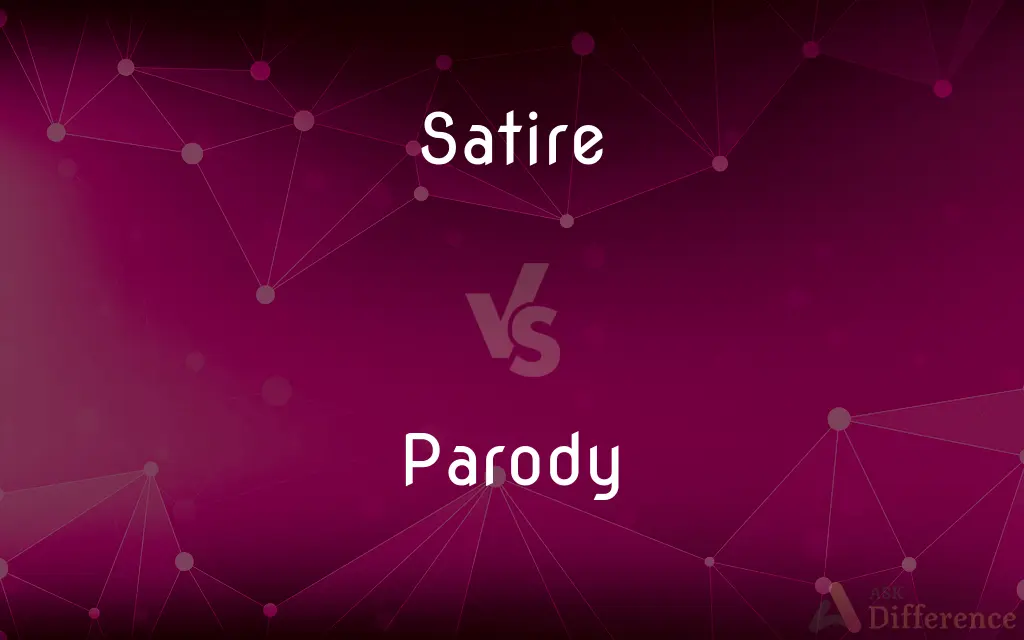Satire vs. Parody — What's the Difference?
By Tayyaba Rehman & Maham Liaqat — Updated on March 24, 2024
Satire uses humor, irony, or exaggeration to critique or mock, while parody imitates for comic effect or ridicule.

Difference Between Satire and Parody
Table of Contents
ADVERTISEMENT
Key Differences
Satire is a literary genre or technique that uses humor, irony, exaggeration, or ridicule to expose and criticize people's stupidity or vices, particularly in the context of contemporary politics and other topical issues. Parody, on the other hand, is a form of humor that imitates the style or content of a work, artist, or genre for comic effect or ridicule, often to highlight the original's flaws or idiosyncrasies.
While satire aims to provoke thought, change, or reform through its critique of society, institutions, individuals, or ideologies, parody primarily seeks to entertain by mimicking and exaggerating its subject. Parody does not necessarily carry the same intent of critique or moral purpose that is fundamental to satire.
Satirical works often employ a wide range of techniques, including irony, understatement, and hyperbole, to achieve their ends. They can be subtle or direct in their critique. Parodies, however, focus on mimicry and exaggeration of specific elements, such as style, technique, or characteristic features of the original work, without necessarily aiming to offer a critique or commentary on broader societal issues.
Satire can exist without directly imitating a specific work, instead targeting broader societal issues, behaviors, or types of behavior in a more general sense. Parody, by its nature, requires a specific target for imitation, whether it be a particular work, genre, or style, making it a more focused form of humor.
The effectiveness of satire lies in its ability to reveal truths and inspire change or reflection through humor and critique. Parody's success, however, is measured by its ability to amuse and entertain through recognizable imitation and exaggeration, with any critique being a secondary effect.
ADVERTISEMENT
Comparison Chart
Primary Purpose
Critique or mock societal issues or behaviors
Entertain through imitation for comic effect
Techniques Used
Irony, exaggeration, ridicule
Mimicry, exaggeration
Target
Broad societal issues, behaviors
Specific works, genres, styles
Intent
Provoke thought, change, or reform
Entertain, possibly with mild critique
Dependency
Can be independent of specific works
Requires a specific target for imitation
Compare with Definitions
Satire
Can target behaviors or ideologies.
Her satirical blog mocks social media obsession, questioning its impact on real-life interactions.
Parody
Secondary critique effect.
While mainly comedic, the parody subtly critiques the original's complexity by simplifying it to ridiculous extremes.
Satire
Aims for social reform.
The cartoonist employs satire to draw attention to environmental neglect, hoping to inspire change.
Parody
Focuses on specific works or styles.
The parody song humorously imitates the artist's unique singing style.
Satire
A genre critiquing society with humor.
Jonathan Swift's A Modest Proposal is a satire that criticizes the British treatment of the Irish by absurdly suggesting they eat their own children.
Parody
Primarily seeks to entertain.
The parody of the famous painting in the magazine made everyone laugh without making a deeper critique.
Satire
Not necessarily imitative.
The novel's satire is not aimed at any one book but rather at the dystopian genre as a whole.
Parody
Utilizes mimicry and exaggeration.
His parody of reality TV exaggerates the drama to absurd levels, revealing its inherent silliness.
Satire
Employs irony and exaggeration.
The satirical news show uses exaggeration to highlight the absurdity of political situations.
Parody
Imitates for comic effect.
The film Spaceballs is a parody of the Star Wars saga, exaggerating characters and plot for humor.
Satire
Satire is a genre of the visual, literary, and performing arts, usually in the form of fiction and less frequently non-fiction, in which vices, follies, abuses, and shortcomings are held up to ridicule, with the intent of shaming individuals, corporations, government, or society itself into improvement. Although satire is usually meant to be humorous, its greater purpose is often constructive social criticism, using wit to draw attention to both particular and wider issues in society.
Parody
A parody, also called a spoof, a send-up, a take-off, a lampoon, a play on (something), or a caricature, is a creative work designed to imitate, comment on, and/or make fun of its subject by means of satiric or ironic imitation. Often its subject is an original work or some aspect of it — theme/content, author, style, etc.
Satire
A literary work in which human foolishness or vice is attacked through irony, derision, or wit.
Parody
A literary or artistic work that uses imitation, as of the characteristic style of an author or a work, for comic effect or ridicule.
Satire
The branch of literature constituting such works.
Parody
A genre, as in literature, comprising such works.
Satire
Irony, sarcasm, or caustic wit used to attack or expose human foolishness or vice.
Parody
Something so bad as to be equivalent to intentional mockery; a travesty
The trial was a parody of justice.
Satire
(uncountable) A literary device of writing or art which principally ridicules its subject often as an intended means of provoking or preventing change or highlighting a shortcoming in the work of another. Humor, irony, and exaggeration are often used to aid this.
Parody
(Music) The practice of reworking an already established composition, especially the incorporation into the Mass of material borrowed from other works, such as motets or madrigals.
Satire
(countable) A satirical work.
A stinging satire of American politics.
Parody
To make a parody of.
Satire
Severity of remark.
Parody
A work or performance that imitates another work or performance with ridicule or irony.
Satire
A composition, generally poetical, holding up vice or folly to reprobation; a keen or severe exposure of what in public or private morals deserves rebuke; an invective poem; as, the Satires of Juvenal.
Parody
A popular maxim, adage, or proverb.
Satire
Keeness and severity of remark; caustic exposure to reprobation; trenchant wit; sarcasm.
Parody
To make a parody of something.
The comedy movie parodied the entire Western genre.
Satire
Witty language used to convey insults or scorn;
He used sarcasm to upset his opponent
Irony is wasted on the stupid
Satire is a sort of glass, wherein beholders do generally discover everybody's face but their own
Parody
A writing in which the language or sentiment of an author is mimicked; especially, a kind of literary pleasantry, in which what is written on one subject is altered, and applied to another by way of burlesque; travesty.
The lively parody which he wrote . . . on Dryden's "Hind and Panther" was received with great applause.
Parody
A popular maxim, adage, or proverb.
Parody
To write a parody upon; to burlesque.
I have translated, or rather parodied, a poem of Horace.
Parody
A composition that imitates somebody's style in a humorous way
Parody
Humorous or satirical mimicry
Parody
Make a spoof of or make fun of
Parody
Make a parody of;
The students spoofed the teachers
Common Curiosities
What is parody?
Parody is a humorous imitation of a specific work, style, or artist, exaggerating it for comic effect.
How do satire and parody differ in purpose?
Satire aims to critique and provoke thought or reform on societal issues, while parody aims to entertain by imitating and exaggerating its subject.
What is satire?
Satire is a technique used in literature and other media to mock or criticize societal issues through humor, irony, and exaggeration.
Is parody dependent on the audience's familiarity with the original work?
Yes, the effectiveness of parody often depends on the audience's ability to recognize and understand the original work being imitated.
How can satire affect society?
Satire has the potential to influence public opinion and inspire societal change by highlighting flaws and absurdities in a thought-provoking manner.
What makes a parody successful?
A successful parody accurately captures and exaggerates the essence of its target in a way that is both recognizable and humorous to the audience.
Do satire and parody always involve humor?
While both are grounded in humor, satire's humor serves a critical purpose, whereas parody's primary goal is entertainment.
Can a work be both satirical and a parody?
Yes, a work can be both if it imitates a specific style or genre for comic effect while also critiquing broader societal issues.
How do creators use parody in media?
Creators use parody in films, literature, music, and art to offer comedic takes on popular works, genres, or styles, often highlighting their quirks or flaws.
Are there any risks associated with satire?
Satire can sometimes be misunderstood or offend the target of its critique, leading to controversy or backlash.
Share Your Discovery

Previous Comparison
Acrylic vs. Polymer
Next Comparison
Agility vs. MobilityAuthor Spotlight
Written by
Tayyaba RehmanTayyaba Rehman is a distinguished writer, currently serving as a primary contributor to askdifference.com. As a researcher in semantics and etymology, Tayyaba's passion for the complexity of languages and their distinctions has found a perfect home on the platform. Tayyaba delves into the intricacies of language, distinguishing between commonly confused words and phrases, thereby providing clarity for readers worldwide.
Co-written by
Maham Liaqat













































